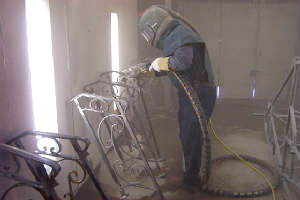EPA Regulations for
Nine Metal Fabrication and Finishing Source Categories
40 CFR Part63 Subpart XXXXXXOverview
In 2008, EPA promulgated requirements to reduce air pollution of compounds of metals such as cadmium, chromium, lead, manganese and nickel from nine metal fabrication and finishing source categories. These compounds pose health risks to anyone who breathes the air when these fumes are present. These compounds are emitted to the air from various operations at metal fabrication and finishing plants.
Existing sources must be in compliance with the regulation before July 25 2011. New sources must be in compliance when they begin to operate.
Applicability
The rule applies ONLY to area sources where the primary activity of the facility is in one of the following nine source categories:
- Electrical and Electronic Equipment Finishing Operations (including motor and generator manufacture, and electrical machinery, equipment, and supplies, not elsewhere classified);
- Fabricated Metal Products;
- Fabricated Plate Work (Boiler Shops);
- Fabricated Structural Metal Manufacturing;
- Heating Equipment, except Electric;
- Industrial Machinery and Equipment Finishing Operations (including construction machinery manufacturing; oil and gas field machinery manufacturing; and pumps and pumping equipment manufacturing);
- Iron and Steel Forging;
- Primary Metal Products Manufacturing; and
- Valves and Pipe Fittings.
Many facilities perform the metal fabrication and finishing processes addressed by this rule, but are not subject to Subpart XXXXXX unless they are "primarily engaged" in operations which are classified in one of the listed nine source categories. To check if you are subject, crosscheck your SIC/NAICS codes with the SIC/NAICS codes that are subject to this rule and listed at this web link: http://www.epa.gov/ttn/atw/area/met-fab-6x-applicability.xls. A more detailed description of the affected source categories is included in the text of the rule, available at http://www.epa.gov/ttn/atw/area/arearules.html.
The regulation contains requirements for five specific processes, described below. Any of these processes at a facility in one of the nine source categories listed above are subject to requirements. The requirements only apply when a process uses materials that contain compounds of cadmium, chromium, lead, manganese, and nickel. Low level use of these metals in the processes may be exempt.
- Dry Abrasive Blasting: Most dry abrasive blasting operations must be enclosed, with a filtration control device. Large objects (> 8 feet) may be blasted without control devices. Small “glove box” operations have lesser requirements.
- Dry Grinding and Dry Polishing with Machines: Emissions must be captured and vented to a filtration control device, and dust in the surrounding areas must be minimized, as practicable.
- Dry Machining: Dust in the surrounding areas must be minimized, as practicable.
- Spray Painting: Spray paint must be applied with high volume low pressure (HVLP) spray guns (or equivalent), workers must be properly trained, and spray guns must be cleaned properly. Most spray painting of objects < 15 feet must be performed in a booth with filters to capture metal particulates. Note: Spray painting operations painting objects > 15 feet, or spray painting any objects in the Fabricated Structural Metal source category are not required to comply with the paint booth and filter requirement.
- Welding: Welding operations must implement one or more of the following management practices to minimize emissions, as practicable, and in accordance with sound welding engineering principles while maintaining weld quality: (i) Use welding processes with reduced fume generation capabilities; (ii) Use welding process variations which can reduce fume generation rates; (iii) Use welding filler metals, shielding gases, carrier gases, or other process materials which are capable of reduced welding fume generation; (iv) Optimize welding process variables to reduce the amount of welding fume generated; and (v) Use a welding fume capture and control system.
Summary of Rules
The regulation requires periodic monitoring for some operations:
- Visible emissions monitoring using Method 22 is required for abrasive blasting performed on large objects (i.e., greater than 8 feet in any dimension) that is not performed in an enclosure vented to a filtration control device. If visible emissions are detected, corrective actions are required until the visible fugitive emissions are eliminated.
- Visible emissions monitoring using Method 22 is also required for welding operations. Welding operations that only use small amounts of rod or wire that contain any of the five metals may be exempt. If visible emissions are detected, corrective actions are required until the visible fugitive emissions are eliminated. However, if visible emissions from welding operations are detected more than one time in a year, opacity testing using Method 9 is then required. An opacity reading of more than 20 percent then results in the requirement to prepare and implement a site-specific welding emissions management plan.
There also are reports that facilities must submit.
- Initial Notification – must be submitted by July 25, 2011 for existing sources and 120 days after startup for new sources. This must be submitted by every facility in one of the nine source categories whether or not any process at the facility is subject to the standards and management practices.
- Notification of Compliance Status report – must be submitted by November 22, 2011 for existing sources and 120 days after initial startup for new sources.
- Annual certification and compliance reports.
More Resources
Small Business Environmental Assistance Program. Section 507 of the 1990 Clean Air Act Amendments requires each state establish a Small Business Environmental Assistance Program (SBEAP) to assist small businesses with environmental compliance and emissions reduction. Find your SBEAP state contact.
For more details and assistance, please talk to your local or state air agency.
Nine Metal Fabrication and Finishing Area Source Categories 40 CFR Part 63 Subpart XXXXXX (6X) NESHAP Questions & Answers (4/2011). This document is a compilation of my answers to emails from states, regions, industry, and other interested parties on the interpretation of the rule.
Nine Metal Fabrication and Finishing Source Categories: Requirements via Flow Charts (7/2008).
Nine Metal Fabrication and Finishing Source Categories Brochure (8/2008).
Nine Metal Fabrication and Finishing Source Categories-Brief Summary (8/2008).


